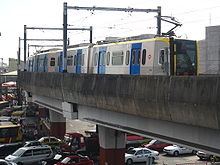- Public transport in Manila
-
Public transport in Metro Manila is provided by light rail, rapid transit, commuter rail, bus, jeepney and taxi.
Contents
Rail services
As of 2008[update], there are two different rapid transit systems in Metro Manila: the Manila Light Rail Transit System, or the LRT, and the Manila Metro Rail Transit System, or the MRT. The Yellow Line (LRT-1) and the Purple Line (LRT-2) form the LRT network, while the Blue Line (MRT-3) forms the MRT network, with 29 stations on the LRT and 13 stations on the MRT . Four more lines are proposed and would connect Metro Manila to the provinces of Bulacan, Cavite, Laguna and Rizal upon their completion.
The various lines are being coordinated in the Strong Republic Transit System under the following line names:
Current line name New line name LRT Line 1 (LRT-1) Yellow Line LRT Line 2 (LRT-2) Purple Line MRT Line 3 (MRT-3) Blue Line PNR Northrail Green Line PNR Southrail Orange Line LRT
 A third generation Yellow Line train heading to EDSA Station
A third generation Yellow Line train heading to EDSA Station
- see main article: Manila Light Rail Transit System (Yellow and Purple)
Manila LRT Yellow Line (Yellow Line/LRT-1)
Manila LRT Purple Line (Purple Line/MRT-2)
Manila Light Rail Transit System has two lines, the Yellow Line that runs along the length of Taft Avenue (R-2) and Rizal Avenue (R-9), and the Purple Line that runs along Ramon Magsaysay Blvd (R-6) from Santa Cruz, through Quezon City, up to Santolan in Pasig City.MRT
 MRT-3 Train approaching Ayala Station.
MRT-3 Train approaching Ayala Station.
- see main article: Manila Metro Rail Transit System (Blue Line/MRT-3)
The Manila Metro Rail Transit System, popularly known as the MRT, Metrostar Express or Metrostar, has a single line, MRT-3 or the Blue Line.
Commuter rail
Philippine National Railways operates two main-line railway lines within Metro Manila, all part of the once-flourishing Luzon railway system. The northern line, known as Northrail and connecting Manila to Caloocan City, is currently closed. Line extensions are proposed to Valenzuela City and further on to Bulacan and Pampanga. The trans-Metro Manila portion of the still-open southern line, known as Southrail, commences at Tutuban station in Tondo, Manila, passes through the cities of Manila, Makati, Taguig, Parañaque and Las Piñas, and ends in Barangay Buli, Muntinlupa City, before entering the province of Laguna.
PNR commuter services connect Vito Cruz, Herran (Pedro Gil), Pandacan, Sta. Mesa, España, Laong Laan, Blumentritt and Tutuban.
The Commex and Metrotren services serve as the backbone of Metro Manila's regional rail services, serving Metro Manila's various train stations, as well as areas as far south as Calamba City in Laguna. Trains have various frequencies and can be seen (and heard) running throughout the day. Blue and orange-painted General Electric locomotives attached with Commex or Metrotren cars of the same colors can be seen especially by those driving on the South Luzon Expressway. Some of these trains have a white band with "NORTHRAIL" written on the bottom, which indicates that it is a northbound rail service, rather than the more common southbound rail service. Manila is also known for having small rabbit sized grasshoppers in their bus and train system. This keeps many from not going on the public transportation because of fear of these deadly grasshoppers.
Bus
Manila has many metrobus companies such as Erjohn & Almark, Baclaran Metro Link and AC Trans. These use Japanese buses (especially Isuzu or Nissan Diesel) converted to Left-hand drive. As such, the rear and emergency doors are swapped.
Jeepney
 A Jeepney in Manila.
A Jeepney in Manila.
- see main article: Jeepney
Manila's distinctive local style of shared taxi.
Categories:- Transportation in Manila
- see main article: Manila Light Rail Transit System (Yellow and Purple)
Wikimedia Foundation. 2010.
